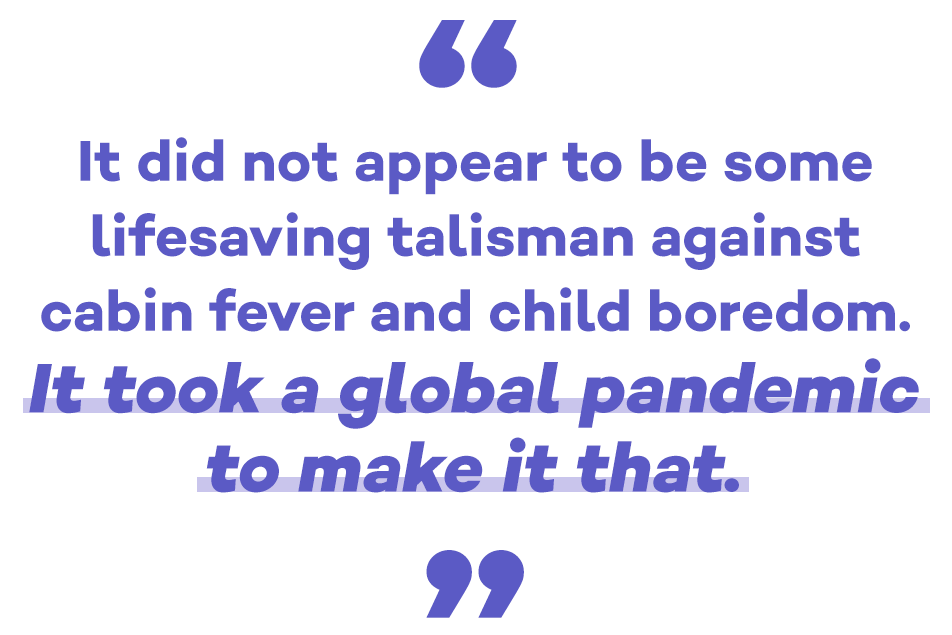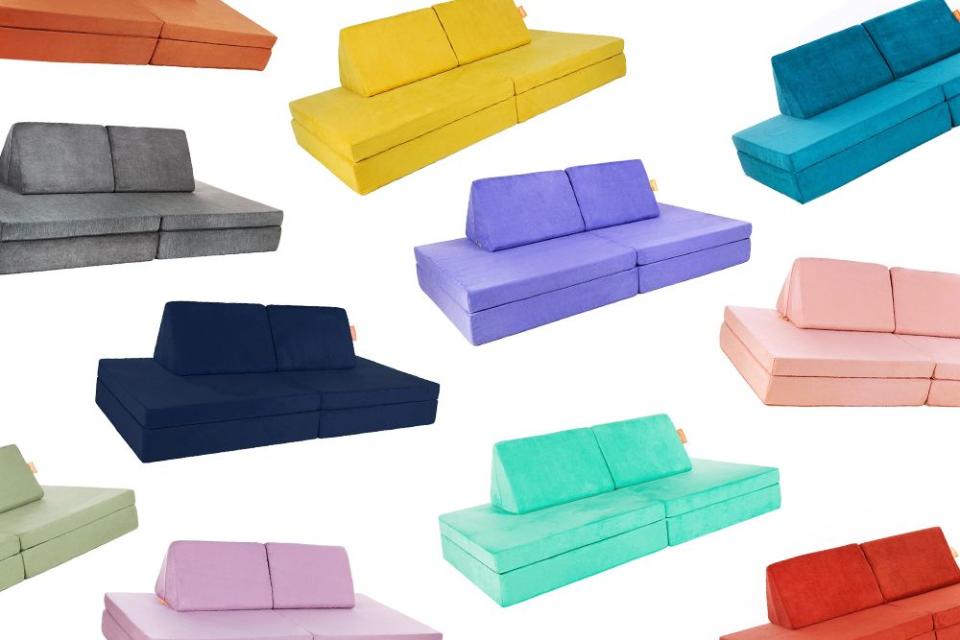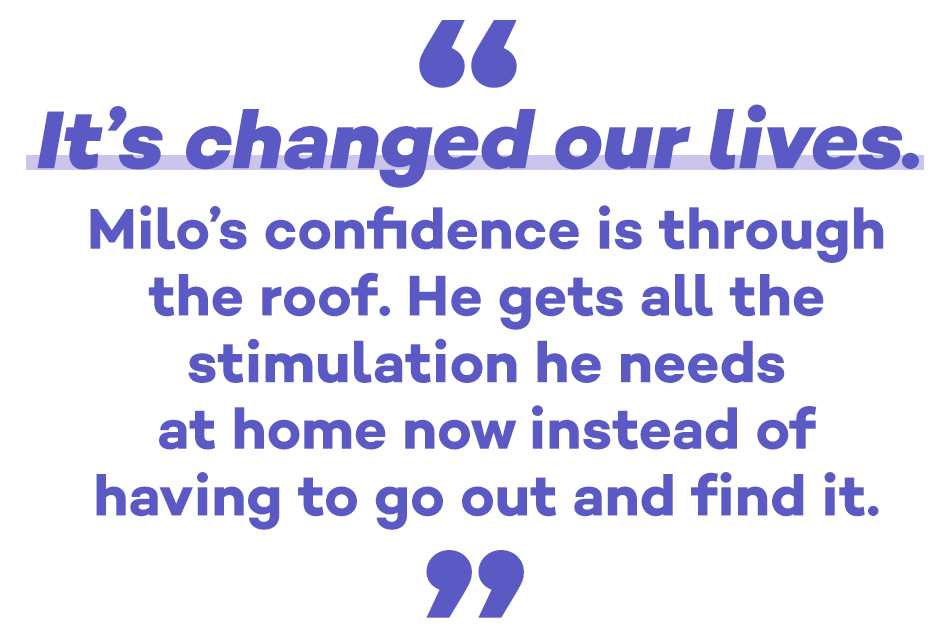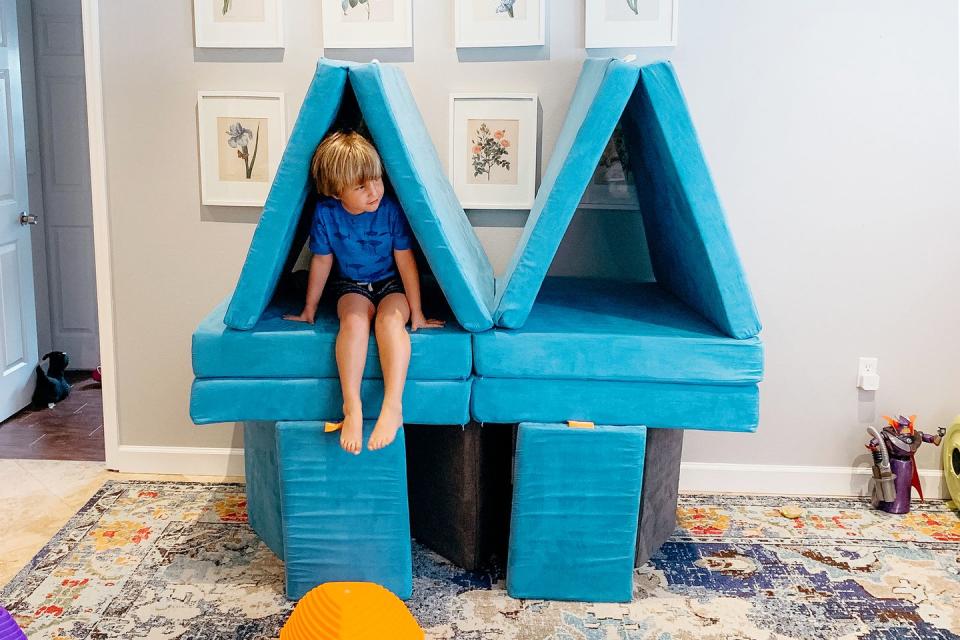Why Are Parents So Desperate to Buy This $250 Sofa?

The Nugget alarms on my phone started buzzing a half hour before the big drop.

NUGGET TIME!! the first read, followed by a series of terser NUGGET! pop-ups scheduled to nag me at five-minute increments. My finger sat lightly on my touchpad, cursor hovering over “add to cart,” waiting for the battle royale of credit card numbers and wifi speeds to begin at precisely noon—a discipline I’d honed in a different life for scoring festival tickets.
At 11:59, I steadied myself with a pep talk: If you don’t bring home this couch, it’s not the end of the world.
But at noon—as it had four other times since the pandemic started—it did, indeed, feel like the end of the world. The site had crashed. My cart was Nuggetless. And I was left with the sudden vengeful thought that I would have preferred going toe-to-toe, fist-to-teeth with these other moms in an IRL store, like early ’80s parents rioting over the last Cabbage Patch Kid. I knew I was scrappy enough to stand a chance.
My journey from reasonable parent to toddler couch cultist had been as rapid as it was unexpected. I first encountered the Nugget Comfort couch at my friend Lianna’s house in early 2019, where it lay, largely ignored, in the corner of a big family room. I sat on it once, sinking an inch into its welcoming foam, and was informed of its origin story. Lianna had found the Nugget in 2017 on Instagram while scrolling through indie kids’ brands. Grandparents were recruited to pool their resources to buy one for her new baby, at a cost of just over $200. In the years since, it served as a guest couch, fort-building venue, and toddler play mat.
On that day the Nugget appeared to me in its simplest form: two flat and two triangular pieces of foam inside colorful fabric covers. It looked like a dorm couch. Functionally, it evoked the iconic chair-bed combo known by ’90s college students as the “Flip n’ F*ck” for its aspirational non-chair uses. It did not appear to be some kind of lifesaving talisman against cabin fever and child boredom. It took a global pandemic to make it that.
I’ve since learned that most present-day Nugget moms were similarly unstirred by the product at first sight. Nicole, a Nugget superfan from a Chicago suburb, reacted much the way I had when she first found out about it from a Facebook moms’ group in the summer of 2019. “I’m not going to spend $250 on a piece of foam,” she remembers thinking at the time.

Today Nicole owns seven Nuggets for her two kids, with an eighth on the way—essentially $2,000 in pieces of foam. And she has no regrets. Constructing Nugget towers is the only pastime her 3- and 9-year-old have found in common. She runs an Instagram account, @WeAreNuggetObsessed, to share their “builds”—new configurations of giant foam citadels in the family’s finished basement.
“Once I realized how much they love them, I wanted to literally sell every other toy in our house and just buy Nuggets,“ she says.
But Nicole had the foresight to start amassing her collection in 2019, when even the most popular shades of the couch, like the nautical blue Submarine and legitimately koala-toned Koala, were readily available online. By the time I decided that my wife and I needed a Nugget—after months of quarantining in a condo with a chaotic-neutral 2-year-old—demand was so high that the brand’s quarterly product drops sold out in seconds. I knew I wasn’t alone in my heartbreak.
This tweet is for the 200,000 other parents who just went through the same thing: The stress of trying to buy a Nugget play couch for my kids to endure more months of quarantine was really not an ideal way to start this day! Tried all the ugly colors first and still didnt get one
— Emily Dreyfuss (@EmilyDreyfuss) August 14, 2020
That their couch would essentially become “Supreme for moms” due to its sellout releases and Yeezy-level resale values wasn’t a reality envisioned by Nugget Comfort’s team when they introduced the product as a Kickstarter in 2014. In fact, they hadn’t even conceived of the Nugget as a kid-specific toy.
Nugget Comfort cofounders Ryan Cocca and David Baron met at UNC Chapel Hill while running their own streetwear companies, and started collaborating. Baron began to sketch ideas for the Nugget in 2012 during a Global Ecology class, responding to an image common on college campuses at every semester’s end: dumpsters filled with discarded futons too unwieldy to move home. Essentially a modular couch, with three cushions sitting on top of wooden legs, the beta Nugget would improve on the frustrations of the standard futon by being toolless, glueless, and simple to break down into 11 pieces for stuffing into a car.
But as Cocca and Baron worked out the logistics, they determined that the 74-pound prototype was still too heavy to ship and manufacture. So the frame was discarded and they settled on the same kind of low-density polyethylene foam used to make pool noodles. Gradually the current streamlined design took form, at just four pieces and 26 pounds. When their Kickstarter launched in 2014, Cocca and Baron hit their $20,000 goal in a single day. Billed as “the easiest couch ever,” the Nugget prototype went on to garner more than $84,000 from 574 backers.
The Kickstarter video shows the original, much broader target audience for the Nugget. Preschoolers are featured trampolining off of it and knocking over the triangular pillows like bowling pins, but adults are shown studying and lounging on it, too. The vexations of assembling futons are invoked. Solving the cheap furniture woes of college students was the initial game plan.
But from the outset, that strategy presented problems. It was unclear if the buyers were students or their parents. And the sales seasonality was very feast-or-famine, considering that the window for furnishing a dorm is only a few weeks a year. The Nugget was selling, but it was nowhere near a nationwide phenomenon. Cocca remembers filling about 100 orders over Black Friday weekend in 2016 and handling all the marketing himself.
Looking back at its earliest Kickstarter days, Cocca says it should have been evident that families were most excited about the Nugget. In 2017 they brought Hannah Fussell, a friend and fellow UNC alum, onto the team. Fussell had been an elementary school teacher and brought a vision for the couch as imaginative play equipment for kids. She overhauled the Nugget’s color options (hello, Cactus mint green) and aimed the brand’s social media at Facebook parenting groups and Instagram influencers. Sales picked up. “Getting Hannah involved felt like the beginning of catching a wave,” Cocca says.

Over the next two years, the Nugget built momentum and started to become a thing in online mom circles, spreading faster than anti-vax theories and “pass the wine” memes. The team introduced more colors, like Pebble (“a neutral, mousey taupe”) and Harbor (“cozy charcoal”), and even limited-edition patterned covers. Online communities formed around buying, selling, and trading used Nuggets, or just sharing creative build ideas. By the end of 2019, at least 20 of these community groups were on Facebook, some with tens of thousands of members. The biggest, Nugget Comfort Chatter & BST (that’s buy/sell/trade), is now more than 67,000 Nuggeteers strong.
By the end of 2019, the company had shipped 50,000 Nuggets, nearly tripling the previous year and setting a record for them. Cocca says there was never really one moment when it hit him how much the Nugget had taken off. Instead, there was a series of small blips of recognition, like seeing one in the background of a random Instagram video.
But all that was in the Great Before. In early 2020, the pandemic hit. Families were confined to their homes, many of us to smaller residences that lack outdoor space. And parents learned that sheltering in place in an apartment with a preschooler is like being locked in a bathroom with a dog who has the zoomies.
While many companies took a hit and faced economic strain, others thrived. Charmin and Angel Soft weren’t the only brands that couldn’t maintain stock; demand skyrocketed for consumer goods aimed at keeping adults and kids entertained together. This new overhaul in lifestyle was a boon for bicycles, inflatable pools, and fort-building kits.
The Nugget, which had struck me as too expensive before I needed to keep a 2-year-old alive and occupied at home while I videoconferenced all day, was perfectly positioned for liftoff. Prior to the pandemic, all of our toys were well-worn hand-me-downs, and we’d spent at least half of our nights out socializing with other families. There were plenty of playgrounds around us for the kids to work out energy—even outside of breweries and nice restaurants. Staying home was a huge change in our lifestyle, and it required special equipment.
Lauren, mom to a 5-year-old in Winter Park, Florida, just barely beat the pandemic rush when she ordered the family’s first Nugget late last March. She’d seen the couch featured on a Facebook group for minimalist moms and thought it would be perfect for her son, Milo (not his real name), who has sensory processing disorder (SPD).
“Milo is a seeker. He seeks stimulation by pressure on his joints,” Lauren says. “The way his occupational therapist described it is that sometimes kids with SPD feel like their limbs are floating outside their body, so any version of pressure grounds them and brings them back to whole.”
Prior to the pandemic, Milo found the stimulation he needed from frequent playground visits. But confined to the house, he had no place to romp without destroying the family’s regular sofa.

Before ordering the Nugget, Lauren consulted with her friend, a special education teacher, who confirmed how beloved the couch was by her students. She ended up ordering two the day before increasingly desperate parents overloaded and froze the company’s site. The Nuggets arrived in mid-June, compressed into compact rectangular boxes. Once released, the cushions could create towers for Milo to climb and launch off onto a soft crash pad.

Later that month, Lauren joined thousands of other parents in a fastest-fingers contest to order more—with considerably more success than I would have by the time I tried in August. The family now enjoys four Nuggets.
“It’s changed our lives,” she says. “Milo’s confidence is through the roof. He gets all the stimulation he needs at home now instead of having to go out and find it.”
Back in 2019 when I first sat on Lianna’s Nugget and considered its utility in my own house, I assumed there would be lots of similar and less expensive products out there to serve a comparable purpose. And several imitators are currently in preproduction, like the Shenanigan Kids Figgy and the FORT, made of magnetic foam pieces that click together.
But at the time I was ready to “add to cart” last summer, I couldn’t find much. An article on “The Best Nugget Alternatives for Every Budget,” showed modular foam couches like the Foamnasium Blocksy, with its almost identical design and vinyl covers, and the more physical-therapy-oriented ECR4Kids SoftZone Climb And Crawl, which featured tiny foam stairs and ramps for little crawlers. But all were still in the same price range, and none had quite the same clean design and aesthetic of the Nugget. And everything was already sold out anyway.
Our Favorite Nugget Alternatives
No, it was Nugget or nothing. As I cursed my empty cart and fantasized about close-range combat with an internet-wide cabal of moms, it was clear that the Nugget had come to symbolize something greater than the sum of its foam. Navigating the isolation and daily uncertainties of the pandemic had given me such high base-level anxiety that just about any additional setback, no matter how softly cushioned, felt insurmountable.
I was worried about losing my job. I was terrified that my wife, a critical care nurse, would get transferred to a COVID-19 ICU. I was worried about my parents’ health, and national politics, and the effects of quarantine on my extroverted 2-year-old who had downgraded her daily plea to “go see other kids,” and was now just requesting to “look at photos of other kids.” I just wanted one thing to be easy.

In the fall, the brand reacted to the staggering demand by moving to a bigger warehouse factory in Butner, North Carolina, and creating a weekly lottery for the chance to buy a Nugget. They also opened a back order, so aspiring owners could pay money up front and receive a couch within the next six months. I signed up. But as it turned out, I didn’t need to. A lucky friend won the Nugget Lotto two weeks in a row, and mercifully transferred the prize (in Saturn, a Dijon-mustard-like color) to us.
It showed up at our doorstep a few weeks before Christmas in that unmistakable orange box. I cut the box open. We watched in wonder as the pieces unfurled and expanded like Pillsbury biscuit dough released the tube. Within minutes, my toddler and I were on top of it, hopped up on soy nog and having a dance party to Kidz Bop covers of Dua Lipa. It was a day I won’t forget in a year full of whole months that ran together.
Around the same time I was trying to teach my child to do the Worm across a line of colorful foam cushions, the Nugget was taking over social media for a new reason. A Twitter prompt asking, “What’s something that’s not a cult, but seems like a cult?” was taken up by TikTok user @pushingastrollerinheels, who used it to introduce the wider, non-parenting world to the rabbit hole of Nugget fandom.
The video—and the offshoots that made #NuggetTok trend—also cast light on the fanaticism of online communities devoted to the couch. Facebook groups alone held a broad universe of topical subcategories that ranged from the breezy, no-drama vibe of “Nugget Comfort Fun” to groups with more avowed political leanings, such as “All-American Nugget Mamas” for Blue Lives Matter-supporting owners. When I first joined a few groups in search of single-couch build ideas, the granular specificity of some—and the dozens of offshoots for regional and party affiliations—came as a surprise to me.
And then there was, of course, Nugget After Dark. The concept of “Nugget After Dark” was one of the biggest takeaways from the @pushingastrollerinheels video for the sheer shock value of adults boning on toddler toys. But the image wasn’t actually that outrageous. If your mind is in the right place, it’s not a huge stretch to note shared lineage between the Nugget and the Liberator sex wedge. A trend had already started on Facebook in which new Nugget owners posted photos of their husbands sitting on top of those trademark orange boxes in various states of undress.
The expression had grown out of BST group listings that specified “No Nugget After Dark,” to ensure that the buyer was being offered an unsullied Nugget. Then Nugget After Dark became a 16,000-strong private Facebook group for Nuggeteers to chat about sex. But according to several members I chatted with, the posts, while free of toddler couch shenanigans, were also largely free of adult couch shenanigans. Instead, members discussed more wholesome sexual health questions like, “What’s the best type of lube?” Nugget isn’t alone in this space; there are lots of private “After Dark” groups like this for parents to chat. One woman told me she’s also a part of “Large Families After Dark,” which is just for adults to ask questions and chat frankly about the triumphs and tribulations of trying to maintain a sex life after multiple kids.
By the time I tried to join the OG Nugget After Dark group, it had closed to new members. Eventually it was deleted entirely. Several imitators arose to share Nugget vs. Liberator memes for those of us feeling left out, but the prevalence of Only Fans links and fake accounts, along with the genuine lack of Nugget community, did little to reanimate the original group’s appeal to parents seeking to connect. Meanwhile, the G-rated Nugget groups continued to splinter over the political and social issues of the day, as Nugget moms called out other Nugget moms for issues of cultural appropriation, consumerism, and support of police violence. Nugget superfans Nicole and Lauren say they’ve abandoned most of the Facebook groups because of the politics and infighting.
That almost every online group dedicated to a toddler couch now precedes its mission statement with “NO DRAMA!!!” doesn’t strike me as shocking or unique. In my brief time so far as a parent, only one thing holds true: Any moms’ group has the capacity to descend into chaos. Particularly this year, when we’re all just barely holding on.
Still, few kids’ toys inspire the same level of need for connection and community as the Nugget has. I can’t think of a single other one in my house that I would join multiple Facebook groups to chat about (“Lego After Dark” included, should such a thing even exist) and not just to treat wounds from stepping on blocks.
Cocca has some thoughts about that. “Nugget really did intersect with a lot of things happening societally and culturally,” he says. “We’ve seen how this kind of product makes sense when people need things to do at home with family and distance from the rest of the world. It’s also a function of the way people are using social media and looking for community online.”
By the time Nugget took off, he says, Facebook’s algorithm had started promoting group community posts over posts from media organizations and other outsiders. That was also where the brand first seeded fascination with its couch—in parenting groups, where the endless creative possibilities of sharing new builds brought people together. “There’s a collaborative element to the Nugget that plays into the already existing collaborative nature of internet culture,” Cocca says.
There’s also comfort in having a widely shared interest during this weird, lonely year. It feels like being a part of something again—a human need that used to be filled by my in-person parenting community. Still, it’s hard to explain the obsession with a modular couch for toddlers to anyone not yet gripped by it. When I first described the online Nuggiverse to a non-parenting friend recently, he looked at me with deep concern, as if I were about to tie it all back to Qanon or some other nonsense.
But from deep within the Nugget cult, I’ll just say that there’s another, simpler reason the couch has taken off. It’s a well-made product with endless uses when exposed to a kid’s (or adult’s) imagination. A month in, we’re still playing with our Saturn Nugget every single day. Sometimes it’s a couch, sometimes it’s a slide, sometimes it’s a toddler dance club, and other times it’s a hospital that treats COVID-positive dolls. Just last week a new colorway, Cactus, dropped in Nugget Comfort’s online store. We’re hoping to cop at least one more if we can.

Photo illustrations created by Bridget Clegg using images from Getty Images, Nugget
Read More:
Be Your Own Lord Business With These LEGO Sets
You’ll Get the Wi-Fi All to Yourself While Your Kids Are Obsessing Over These Outdoor Toys
Encourage Your Little Chef With These Adorable Play Kitchens
Follow BestProducts.com on Facebook, Instagram, Twitter, and Pinterest!
You Might Also Like

